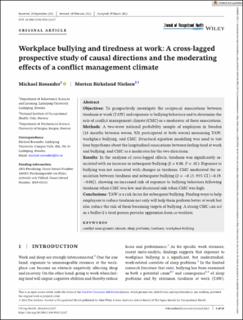Workplace bullying and tiredness at work: A cross-lagged prospective study of causal directions and the moderating effects of a conflict management climate
Peer reviewed, Journal article
Published version
Permanent lenke
https://hdl.handle.net/11250/3042468Utgivelsesdato
2022Metadata
Vis full innførselSamlinger
Sammendrag
Objectives To prospectively investigate the reciprocal associations between tiredness at work (TAW) and exposure to bullying behaviors and to determine the role of conflict management climate (CMC) as a moderator of these associations. Methods A two-wave national probability sample of employees in Sweden (18 months between waves, 921 participated at both waves) measuring TAW, workplace bullying, and CMC. Structural equation modelling was used to test four hypotheses about the longitudinal associations between feeling tired at work and bullying, and CMC as a moderator for the two directions. Results In the analyses of cross-lagged effects, tiredness was significantly associated with an increase in subsequent bullying (β = 0.08, P = .01). Exposure to bullying was not associated with changes in tiredness. CMC moderated the association between tiredness and subsequent bullying (β = −0.13, 95% CI [−0.19, −0.08]), showing an increased risk of exposure to bullying behaviors following tiredness when CMC was low and decreased risk when CMC was high. Conclusions TAW is a risk factor for subsequent bullying. Finding ways to help employees to reduce tiredness not only will help them perform better at work but also reduce the risk of them becoming targets of bullying. A strong CMC can act as a buffer if a tired person provoke aggression from co-workers.
